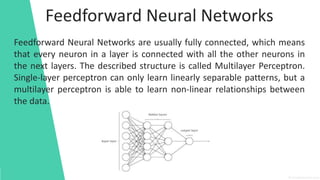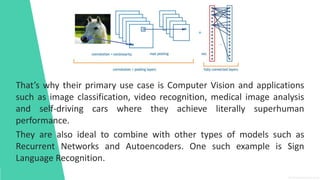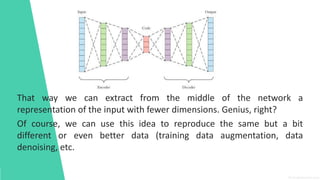Deep learning
- 1. Deep Learning Presented by- Saurav Jaiswal A8805217007
- 2. What is Deep Learning ? Deep Learning is a subfield of machine learning concerned with algorithms inspired by the structure and function of the brain called artificial neural networks.
- 3. Deep Learning Algorithms/Models The most important Deep Learning algorithms and architectures concieved over the years for use in a variety of applications such as Computer Vision and Natural Language Processing. Some of them are used more frequently than others and each one has its own streghth and weeknesses.
- 4. Neural Networks Just like the human brain, Neural Network consist of Neurons. Each Neuron receives signals as an input, multiplies them by weights, sums them up and applies a non-linear function. These neurons are stacked next to each other and organized in layers.
- 5. Feedforward Neural Networks Feedforward Neural Networks are usually fully connected, which means that every neuron in a layer is connected with all the other neurons in the next layers. The described structure is called Multilayer Perceptron. Single-layer perceptron can only learn linearly separable patterns, but a multilayer perceptron is able to learn non-linear relationships between the data.
- 6. Convolutional Neural Network Convolutional Neural Networks employ a function called convolution The concept behind them is that instead of connecting each neuron with all the next ones, we connect it with only a handful of them (the receptive field). In a way, they try to regularize feedforward networks to avoid overfitting (when the model learns only pre-seen data and can’t generalize), which makes them very good in identifying spatial relationships between the data.
- 7. That’s why their primary use case is Computer Vision and applications such as image classification, video recognition, medical image analysis and self-driving cars where they achieve literally superhuman performance. They are also ideal to combine with other types of models such as Recurrent Networks and Autoencoders. One such example is Sign Language Recognition.
- 8. Autoencoders Autoencoders are mostly used as an unsupervised algorithm and its main use-case is dimensionality reduction and compression. Their trick is that they try to make the output equal to the input. In other works, they are trying to reconstruct the data. They consist of an encoder and a decoder. The encoder receives the input and it encodes it in a latent space of a lower dimension. The decoder takes that vector and decodes it back to the original input.
- 9. That way we can extract from the middle of the network a representation of the input with fewer dimensions. Genius, right? Of course, we can use this idea to reproduce the same but a bit different or even better data (training data augmentation, data denoising, etc.
- 10. Deep Learning Libraries Deep Learning libraries provide pre-written, professional-quality code that you can use for our own projects. ... For a commercial-grade deep learning application, the best libraries are- • TensorFlow • Keras • Caffe • PyTorch • Theano • Caffe2









